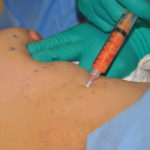While fat grafting has a long history in plastic surgery, its use as an injectable filling material is much more recent. Fat injections today are a well recognized technique for use in the face, hands, and buttock for soft tissue filling and augmentation. Fat injections into the breast have historically been much more controversial due to a higher rate of perceived complications and potential interference with breast diagnoses. However, improved fat purification and more refined injection techniques have eliminated most of these concerns.

Fat has been shown to contain stem cells, thought previously to be most prevalent in the bone marrow. Fat appears to contain at least as many stem cells per volume, if not more, than bone marrow. Therefore, stem cell-enhanced fat injections may be a more accurate description of what we are doing. By harvesting and concentrating fat by centrifugation (or even sieve filtering), we are concentrating the stem cell/fat ratio which improves the potential interaction between the harvested fat cells and those cells of the tissues into which it is injected. Whether it is stimulatory chemical factors that are released from the stem cells or the creation of new cells from stem cell differentiation, or both, is not known and remains to be elucidated by further research.
One fear about this ‘natural’ use of stem cell therapy is that the stem cells themselves pose a risk to the breast by potentially turning into cancer cells. This result has never been shown and it is fair to say that stem cells injected into the breast are no more likely to turn cancerous than anywhere else in the body. A stem cell injected into breast (connective tissue) will follow local tissue signals and differentiate into new connective tissue.
While the optimal methods to concentrate or stimulate stem cells for fat injections into the breast (and elsewhere)is not precisely known, there are several methods that I currently use in my Indianapolis plastic surgery practice. Centrifuging liposuction-harvested fat is a standard technique. This is probably better than simple filtering and is only slightly more difficult to do. I also like to add platelet-rich plasma (PRP) concentrate (from 60cc of the patient’s blood) to the final fat aliquot to produce a ‘super-charged’ type of fat injection.While this is a bit of an alchemy or cocktail approach, there is pretty good science for fat concentration and PRP methods. It is only logical to assume that the combination is likely better than either one alone.
While fat injection in breast reconstruction is fairly accepted both for lumpectomy and around breast implants, cosmetic use of fat injections to the breast is just coming into vogue. At this time, there are numerous good clinical studies and experiences about the use of fat for breast augmentation . How to make it the most effective, however, needs further scientific and clinical study.
Dr. Barry Eppley
Indianapolis, Indiana


